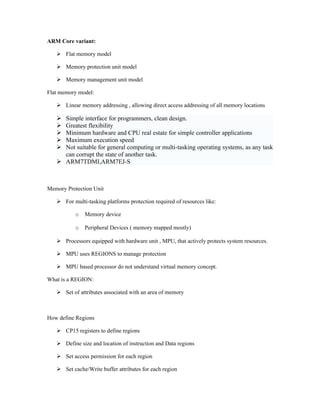
Type of Embedded core
- 1. ARM Core variant: Flat memory model Memory protection unit model Memory management unit model Flat memory model: Linear memory addressing , allowing direct access addressing of all memory locations Simple interface for programmers, clean design. Greatest flexibility Minimum hardware and CPU real estate for simple controller applications Maximum execution speed Not suitable for general computing or multi-tasking operating systems, as any task can corrupt the state of another task. ARM7TDMI,ARM7EJ-S Memory Protection Unit For multi-tasking platforms protection required of resources like: o Memory device o Peripheral Devices ( memory mapped mostly) Processors equipped with hardware unit , MPU, that actively protects system resources. MPU uses REGIONS to manage protection MPU based processor do not understand virtual memory concept. What is a REGION: Set of attributes associated with an area of memory How define Regions CP15 registers to define regions Define size and location of instruction and Data regions Set access permission for each region Set cache/Write buffer attributes for each region
- 2. About Regions: Regions can overlap other regions Regions are assigned priority number When overlapping, attributes of higher priority region takes precedence over other Regions starting address is multiple of its size Size range from 4KB – 4GB Example: OS protected Regions, Peripheral Region, Task1 Region, Task2 Region etc… ARM946E-S MMU Protection of Resources Provides resourced to enable Virtual memory ARM1026EJ-S Core instructions to support Multi-processor/core systems: Instruction to provide lock-free atomic “read-modify-write” operation LL/SC ( Load-link / Store-conditional ) Purpose is to maintain shared-data integrity by preventing 2 masters making conflicting access at the same time. Armv6 onwards (also armv5te) provides LL/SC instructions : LDREX/STREX to provide exclusive access. Memory Alias: Accessing a memory region through different address range (alias) For example 0x10000000 alias address maps to physical address 0x00000000 Specific to chip design and works at hardware level Alias generator block that captures the CPU address to get the actual address Nothing to do with software. In our case : Arm9 can have 3 alias memory addressing : 0x10000000,0x20000000,0x30000000 mapping to physical RAM at 0x00000000
